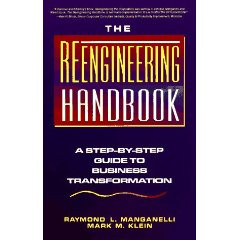|
A Step-By-Step Guide to Business Transformation

Reengineering has emerged as the foremost business improvement technique of this decade. Manganelli and Klein, the CEO
and managing director of a reengineering consulting firm, respectively, cover the specific processes for managers to follow
in order to reengineer their companies successfully. Their technique, which they call Rapid Remethodology, is a five-stage
program, and each section of the book includes directions, checklists, and examples to use while proceeding through the stages.
Designed for use by all types of businesses and for managers at different levels, this work includes lists of resources as
well as suggestions drawn from companies that have successfully completed the process. It will be useful to managers interested
in reengineering, though Michael Hammer and James Champy's Reengineering the Corporation (HarperBusiness, 1993) gives a more
thorough background.
Gary W. White, Pennsylvania State Univ., Harrisburg
|
|
p.132 The purpose of this stage [Stage 4a: Solution: Technical Design] is to produce
a process design capable of achieving the process vision. This stage answers the question "How?"... Business process
reengineering (BPR) is enabled by three factors or forces: technology, information, and human potential. BPR seeks to leverage
these three forces into breakthroughs in process performance.
We often neglect to mention information as one of the enablers... But information is an enabler in
its own right
p.137 Model Entity Relationships
This task identifies the relationships among entities. It also defines the direction and
cardinality of the relationships, i.e., whether the relationship is one-to-one, one-to-many, or many-to-many, and which entity
"owns" which other entity. Since entities are the "things" with which a process is concerned, the technical elements of the
process includes information (i.e., collections of data) about the entities. This task is a first step in modeling the data.
|
 |
|
|
 |
|
|
 |
|
|
|

